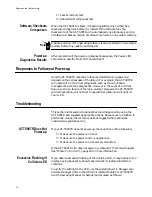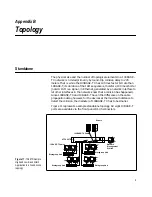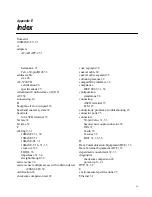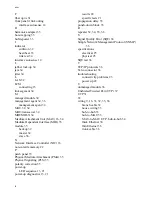
Glossary
36
RJ45—This connector is a 10BASE-T standard for connecting UTP
cabling. They are inexpensive and easy to install onto UTP cable.
SIGNAL QUALITY ERROR (SQE)—Also referred to as Collision or
Collision Presence. This occurs when two devices attempt to transmit at
the same time which is an illegal condition.
SIMPLE NETWORK MANAGEMENT PROTOCOL (SNMP)— SNMP
is a TCP/IP protocol that generally uses the User Datagram Protocol
(UDP) to exchange messages between a management information base
and a management client residing on a network. Since SNMP does not
rely on the underlying communication protocols, it can be made available
over other protocols, such as XNS or DECnet.
SLAVE— A repeater that behaves as a “dumb” module managed by a
Master in a department concentrator chassis. Slaves operating standalone
perform only simple regeneration and retiming tasks associated with
repeating and are not manageable.
SQE TEST—Commonly referred to as Heartbeat, is a special 802.3 signal
sent by the MAU to the DTE to test the collision detection function. Some
DTE want SQE and others do not. Repeaters do not want SQE Test.
STANDALONE—Repeater operating as a hub on its own; i.e., not a
module among other modules in a department concentrator chassis.
STRAIGHT-THROUGH—A type of wiring connection where the pins of
one connector connect to the same pins of another connector. For example,
pin 1 of one connector connects to pin 1 of another connector.
TCP/IP PROTOCOLS—A set of protocols for inter-computer
communication, including network level (Internet Protocol), transport
level (Transmission Control Protocol or TCP), and application level
protocols (for example, Telnet terminal emulation). TCP/IP has been used
for many years in two country-wide networks, the ARPANET and
MILNET. Recently, TCP/IP has become very popular with users of a
variety of multi-user computer systems and engineering workstations.
Most UNIX computers use TCP/IP over Ethernet as the main inter-
computer networking technology. TCP/IP is also popular among PC users,
particularly as a means of communication with large multi-user
computers.
TELCO CONNECTOR— A 50-pin receptacle that plugs into the front of
the hub, enabling cables from external devices to connect to the hub.
THICK ETHERNET—See 10BASE5
THIN ETHERNET—See 10BASE2
TRUNK CABLE—The trunk coaxial cable system.
UNMANAGED MODULE— A repeater that behaves as a “dumb”
repeater in a department concentrator chassis (i.e., without a Master). It
performs simple repeating tasks like packet retiming and regeneration,
but is not managed.



































